
Since there are major benefits to reducing "acidity" and becoming more “alkaline,” how do you go about it? First we have to define the two terms, and it is important to realize that “metabolic acidity” is different from the acid level in your stomach or GI tract, which is what most people associate with being over-acidic. (Most people would do very well with more stomach acid...but that is a topic for another article.)
pH Chart Explained
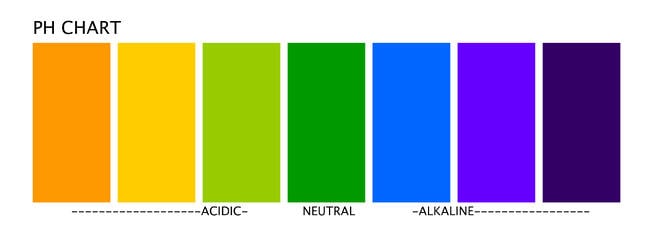 Strictly defined, pH is a measure of hydrogen ion concentration, [H+]. On the 14-point pH scale, pure distilled water is right in the middle with a neutral pH of 7.0. As the H+ concentration goes up, the pH reading goes down, and “acidic” refers to a pH of below 7. Conversely, as the H+ concentration goes down, and other alkaline factors go up the pH reading increases. So above 7 is increasingly “alkaline”.
Strictly defined, pH is a measure of hydrogen ion concentration, [H+]. On the 14-point pH scale, pure distilled water is right in the middle with a neutral pH of 7.0. As the H+ concentration goes up, the pH reading goes down, and “acidic” refers to a pH of below 7. Conversely, as the H+ concentration goes down, and other alkaline factors go up the pH reading increases. So above 7 is increasingly “alkaline”.
Given that your gastrointestinal tract is basically a semi-porous tube that runs through you, what metabolic acidity or alkalinity refers to is the pH of your blood and tissues beyond your GI tract, (even though one obviously affects the other).
Becoming more metabolically alkaline involves building your alkaline reserve. Alkaline reserve refers to our capacity to produce bicarbonate ion to buffer excess acidity and keep our blood in the vitally important range right around pH 7.4. It also refers to available mineral stores, such as those from our bones that can be used to buffer excess acid.
Our lungs are the most immediate method of maintaining our essential pH, via expired carbon dioxide, whereas the kidneys accomplish such effects more completely, but over a longer period by retaining bicarbonate ion and buffering excess acid with minerals like calcium, magnesium, or potassium.
As mentioned in part 1 of this article, the kidneys can also use citrate mineral salts, 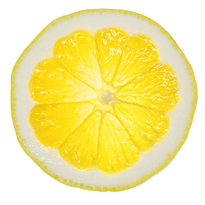 particularly potassium citrate to buffer and excrete excess acid, and this is reflected in the urine becoming more alkaline when you test its pH with litmus paper. High levels of such citrates are actually why raw lemons and other citrus fruits are some of the most metabolically alkalinizing foods.
particularly potassium citrate to buffer and excrete excess acid, and this is reflected in the urine becoming more alkaline when you test its pH with litmus paper. High levels of such citrates are actually why raw lemons and other citrus fruits are some of the most metabolically alkalinizing foods.
Yet testing urine pH can at times be misleading, and may not provide an accurate internal picture. For example, end-stage cancer patients often have extremely alkaline urine because their kidneys are drawing-on and excreting so much bicarbonate in an attempt to offset their extremely acidic condition. If you were just to look at their litmus test you might say, “Well, this person is alkaline”, when the opposite is actually true.
For such reasons I often tell people what's more important than any single reading is the change in their urine or saliva pH over time, while gauging how they feel. It’s the general directional trend that’s important.
Also, be aware that just because a food is net-acidic doesn’t necessarily make it unhealthy! Acidic or alkaline is only one aspect of desirability, and does not itself dictate whether a food is beneficial or not. For example, many meats, though metabolically acidic, are extremely nutrient-dense. Furthermore, the importance and benefits of eating adequate protein has been thoroughly established, but it’s all about maintaining the right balance! (Note: I am not saying meat is right for everyone, and there are big problems with conventionally produced "agribusiness" meats!)
Some hardcore “acid/alkalinists”…[a made-up term]…will tell you to stick to the 80/20 rule. That is 80% of what you eat by volume should be alkaline and raw, and 20% acidic/cooked. (Note: this doesn’t necessarily mean that if a food is cooked it is acidifying, but the more denatured a food is the more likely it is to create an immune response, and a net acidic effect…see below). But I would say if you are at a 70/30% ratio you’re doing great, and even a 60/40 ratio is good in terms of what will create optimum health. That is 60-70% vegetables and fruits, and 30-40% healthy proteins, fats, and other carbs.
In the end we're all individuals, and you have to find out what works for you and go with the results.
Strategy #1: Eat Lots of Vegetables and Fruits
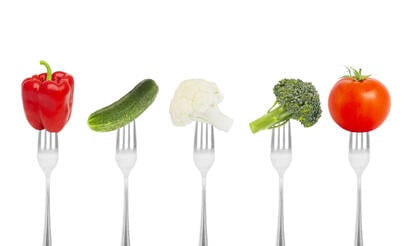
As mentioned in part 1 of this article, though there are a few exceptions on either side, in general, fruits and vegetables are net-alkaline, and meats, grains, and dairy are net-acidic. [1] So the first basic step to becoming more metabolically alkaline is to eat a lot of vegetables and fruit, particularly raw, (or at least partially so), and I would also say particularly green. In addition to increasing your alkalinity, raw green, chlorophyll-containing, magnesium-rich vegetables confer a whole host of benefits unto themselves. Light steaming or blanching is fine, and actually in some cases makes certain nutrients more available. But I believe there is still a unique benefit in eating at least a good portion of your produce whole and raw.
Yet at times the biggest obstacle can be that you get tired of chewing. In this case using a high-powered blender like the Vita-mix is an excellent, convenient way to get a lot of fruits and vegetables into smoothies that can be very tasty and satisfying, and packed with all sorts of nutrients. By adding high quality fats and proteins to these shakes, they can be turned into very balanced meals.
Strategy #2: Use Appropriate Mineral Salts
A Fast Way To Reduce Acidity.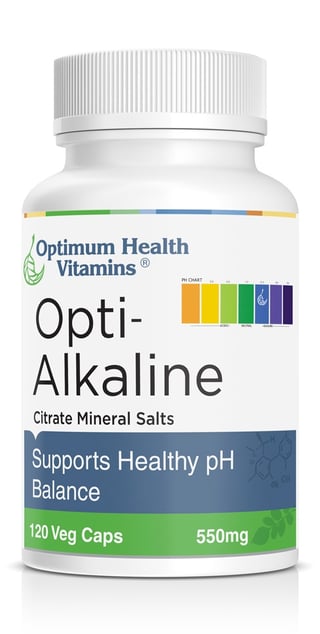 To quickly reduce acidity you can use citrate mineral salts. In this regard, Optimum Health Vitamins offers Opti-Alkaline…a citrate mineral salt combination providing Potassium, Magnesium, Calcium, and Sodium citrates.
To quickly reduce acidity you can use citrate mineral salts. In this regard, Optimum Health Vitamins offers Opti-Alkaline…a citrate mineral salt combination providing Potassium, Magnesium, Calcium, and Sodium citrates.
[Note: if you are using prescription drugs classed as either ACE inhibitors or Angiotensin II receptor blockers for high blood pressure, please check with your doctor before using any potassium supplements. Also realize that the amount of potassium in many fruits and vegetables is high enough that it can make the amounts in many supplements somewhat irrelevant.]
At one of my early IFM symposiums, I will always remember veteran functional medicine practitioner Sydney Baker M.D. saying that in decades of practice one of his two all-time most versatile, useful remedies to bring relief to his patients was Alka Seltzer Gold, (the other being activated charcoal). Not only did Dr. Baker use this alkalinizing product for heartburn or GERD, but a wide range of conditions involving pain and discomfort. And what is Alka Seltzer Gold? When added to water, after the CO2 releases and the fizz dies down, the ingredients it provides are potassium and sodium citrate. (Opti Alkaline just skips the effervescent reaction and provides a wider spectrum of citrate minerals in capsule form.)
This was completely consistent with what we at Optimum Health had started seeing several years prior, i.e. that citrate mineral salts reduced pain. Yet when combined with various natural anti-inflammatory herbs, (which we soon put together in our original Opti-A.I. formula), the two produced a synergystic effect for unplugging pain and inflammation. And why is that?
Strategy #3 - Reduce Inflammation
 As discussed in part 1 of this article, the more intense an inflammatory response, the more oxidation it brings with it. (To picture this, think of a hot dry wind withering and crumpling a nice fresh leaf.) And if there is enough oxidation it disrupts the balance necessary for your cellular furnaces called mitochondria to normally use oxygen and produce energy. When this reduction in mitochondrial efficiency reaches a high enough magnitude it creates a shift to “anaerobic” metabolism, (meaning “without oxygen"). Anaerobic metabolism or “fermentation” produces lactic acid as a waste product, and the increased acidity, i.e H+ concentration, is not only capable of creating pain, (like the burning in your legs when you are sprinting and run out of oxygen), the additional hydronium ion also adds to the oxidative state of the cell, further exacerbating the inflammation that caused it in the first place, and a vicious cycle is set in motion.
As discussed in part 1 of this article, the more intense an inflammatory response, the more oxidation it brings with it. (To picture this, think of a hot dry wind withering and crumpling a nice fresh leaf.) And if there is enough oxidation it disrupts the balance necessary for your cellular furnaces called mitochondria to normally use oxygen and produce energy. When this reduction in mitochondrial efficiency reaches a high enough magnitude it creates a shift to “anaerobic” metabolism, (meaning “without oxygen"). Anaerobic metabolism or “fermentation” produces lactic acid as a waste product, and the increased acidity, i.e H+ concentration, is not only capable of creating pain, (like the burning in your legs when you are sprinting and run out of oxygen), the additional hydronium ion also adds to the oxidative state of the cell, further exacerbating the inflammation that caused it in the first place, and a vicious cycle is set in motion.
Combining alkaline mineral salts and natural anti-inflammatories can unplug this cycle by addressing both ends of it, i.e. the inflammation that started it, and the end result, acidity. And if you got the impression that this general strategy can also be applied to improve the ability to exercise, or athletic performance you would be right.
After all, whether you use up all your oxygen with exercise, or just can't use it because you are inflamed, the end result is the same...the cell switches into its back-up system of fermentation. This is a very inefficient method of producing energy, yielding only 2 molecules of ATP per molecule of glucose, rather than than 36...and what ensues? Fatigue! So for all of you that are just too fatigued to exercise, take note!
Strategy #4: Stop Eating Foods You React To!
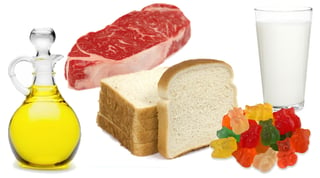
This inflammatory, energy draining, acidifying effect can also come into play when someone has a strong enough immune response to something that they eat or drink.
When you set out to eat foods to help you become less acidic, and more metabolically alkaline, and you consult lists to see which foods are which, the first thing you probably notice is that all the lists say something different. One source says a given food is alkalinizing, and the next says it is acidic. This is a very common source of confusion in the area.
Yet, the one thing that isn’t addressed in the myriad of these food lists is that if you have an inflammatory immune response to a food then it is going to be metabolically acidifying FOR YOU! This means that even foods that are classically labeled as "healthy" are not healthy for you if you react to them. The easiest example to pick is whole grains containing Gluten.
If you have ever seen the absolute laundry list of health challenges and diseases that are caused by, or related to immune responses to gluten, then you get the idea of just how important it is to consider which foods you might be reacting to. In turn, your immune response to foods can be a definitive aspect of whether a given food is metabolically acidic or alkalinizing for you.
Determining which foods you react to is an extremely important factor not only in achieving acid/alkaline balance, but is an absolutely essential component of achieving optimum health. If you are having immune and inflammatory responses to the foods you are eating, you will never be fully well.
Strategy #5: Drink Ionized Alkaline Water
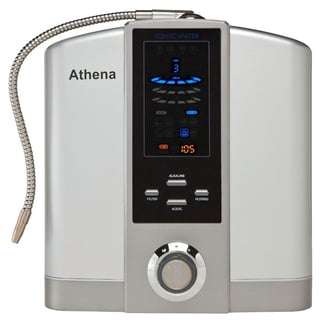
Your body has incredible buffering capacity. It is amazing how much acid or alkaline can be put into someone's system, and have their body just buffer it out. So simply drinking alkaline water does not necessarily mean your tissues will immediately turn alkaline, but over time it can still be a big factor.
There are benefits to drinking ionized alkaline water that are consistently and repeatedly borne out in the results people report, i.e. more energy, clearer thinking, less pain, and feeling better hydrated.
To briefly explain the idea behind ionized water, imagine a neutral molecule of water: H2O. Now picture it being pulled apart into one H+ and one OH-. The H+ is acidic, and as we have not brought up till now, OH- is basic in that it could easily accept the H+ back. The more OH- ions present in water, the more H+ neutralizing potential it has, and hence the more basic it is. And this is easily shown with litmus paper...the more basic water is the darker blue the strip turns.
The idea behind an ionizer is that it uses an electric current to separate H2O into H+ and OH- and then divides them into two streams of water, the H+ rich stream being more acidic, and the OH- stream being more basic. And depending on the strength of the ionizing current that is applied, you can make this process happen to a greater or lesser degree. While the acidic stream is usually discarded down the drain, what comes out the tap is the alkaline water, which usually tests between about pH 7.5 - 9.5.
So getting this water into your tissues can neutralize excess acidity. And because the water is ionized (charged) it has less surface tension than neutral water, so penetrates your tissues more easily. Also, due to the smaller charged ions, the water molecules are also said to cluster more tightly, again serving to "make the water wetter", and get it into your tissues more readily.
Without debating the validity of the concept, i.e. why or if it works, I will simply say that I was introduced to the idea of ionized, alkaline water in 1996, and decided to try it. I have been drinking it ever since, because whenever I stop for any prolonged period, I simply don't feel as well. I feel like I'm not as well hydrated, more thirsty, and have less energy. Then when I start drinking it again, I repeatedly notice the opposite, including clearer thinking......and at that point I could care less what any critics think.
Yet some of our customers have gotten much more dramatic results than this, having reductions in pain and fibromyalgia, and increases in energy, even when they had tried a long list of other natural or other approaches to help. And this is consistent with what we have been taking about in terms of reducing tissue acidity.
If you are curious and want to try some of the ionized water, it really doesn't take much to get jugs of it from our stores or someone who owns an ionizer, and try it for a couple of weeks. Then you be the judge. The only thing to know is that you should start on a low ionization level and gradually increase the alkalinity level of the water, as starting with water that is too alkaline, or increasing too quickly definitely has the potential to make you feel unwell. Also don't assume that higher alkalinity is better. (For example, I have always found for myself that, out of 4 levels, I feel the best at levels 2 or 1, between approximately pH 7.5 to 8.) I have also known people who have gone into metabolic alkalosis when going to extremes with alkaline water, and this is very ill-advised...though it doesn't take them long to figure this out for themselves!
In the end I believe the concept of metabolic alkalinaization will join a long list of natural strategies, (like fiber, or herbs, or probiotics, or omega 3 fats, etc, etc.), that the establishment laughed at for years, and when the evidence continued to mount, finally came into vogue, and then were "discovered".
Strategy #6: Use "Nrf2 Activators" to Dramatically Enhance Your Health.
So if inflammation makes you acidic, and acidity feeds back and adds to your inflammatory state, then addressing them simultaneously with dietary strategies, alkaline mineral salts and anti-inflammatory formulas makes perfect sense. It produces synergistic results, and it is a principle that we at Optimum Health Vitamins have utilized with huge success ever since 2002 when we came out with our original Opti A.I.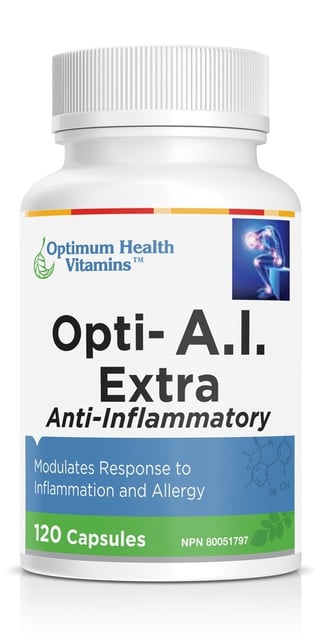 Yet our most comprehensive anti-inflammatory formula is Opti-A.I. Extra This formula contains all the same ingredients as our original Opti-A.I., with two additions: Nettle Root for its immune modulating effects, and Resveratrol for its Nrf2 activation.
Yet our most comprehensive anti-inflammatory formula is Opti-A.I. Extra This formula contains all the same ingredients as our original Opti-A.I., with two additions: Nettle Root for its immune modulating effects, and Resveratrol for its Nrf2 activation.
Many may be familiar with the effects of resveratrol on cell repair and aging. It specifically increases the activity of DNA repair enzymes known as sirtuins. Due to this resveratrol got a lot of publicity for its effects on numerous markers of aging. But an under-appreciated aspect of aging is inflammation, and resveratrol is highly antinflammatory.
Moreover, Resveratrol is one of a set of botanical constituents known as Nrf2 activators, (pronounced “Nerf 2”), and if that name sounds strange, you better get used to it because in years to come Nrf2 Activators are going to be hailed as a major breakthrough!
In the Future You Will Be Hearing A Lot About Nrf2.
 Nrf2 is a protein that under normal circumstances floats around in the cytoplasm of your cells. (To picture this, think of a whole unbroken egg. The cytoplasm in our cells is kind of like the egg white. The nucleus of our cell, where all of your genes are, is like the egg yolk. And the eggshell in this analogy is roughly comparable to the outer cell membrane.) Normally, Nrf2 floating in the cytoplasm remains inactive because it is tethered to another protein termed “Keap1”. But when the cell is exposed to oxidative stress be it heat stress, chemical stress, or inflammatory stress for example, Nrf2 is released and it floats down the genetic material in the nucleus, and binds to what’s called the Antioxidant Response Element (ARE). This activates over 200 highly protective genetic responses, not the least of which are that it is hugely antioxidant, highly anti-inflammatory, it dramatically upregulates detoxification, and majorly supports mitochondrial function and energy production.
Nrf2 is a protein that under normal circumstances floats around in the cytoplasm of your cells. (To picture this, think of a whole unbroken egg. The cytoplasm in our cells is kind of like the egg white. The nucleus of our cell, where all of your genes are, is like the egg yolk. And the eggshell in this analogy is roughly comparable to the outer cell membrane.) Normally, Nrf2 floating in the cytoplasm remains inactive because it is tethered to another protein termed “Keap1”. But when the cell is exposed to oxidative stress be it heat stress, chemical stress, or inflammatory stress for example, Nrf2 is released and it floats down the genetic material in the nucleus, and binds to what’s called the Antioxidant Response Element (ARE). This activates over 200 highly protective genetic responses, not the least of which are that it is hugely antioxidant, highly anti-inflammatory, it dramatically upregulates detoxification, and majorly supports mitochondrial function and energy production.
The take-home point is that there is a large group of botanicals which have been identified to activate this highly protective system. Botanicals like Resveratrol, Curcumin, Rosemary, EGCG from Green Tea, Boswellia, Quercetin, Sulforaphane from broccoli seed extract, Chlorophyll, Garlic, Ginkgo biloba, Ginseng, Grape Seed Extract, Astragalus, Alpha Lipoic Acid, Ashwagandha, Milk Thistle, Bacopa, Oregano…and the list continues to grow as the research on Nrf2 Activators explodes.
Not only will these herbs and botanicals help keep you out of inflammation and to remain alkaline, they present a huge opportunity for improving so many of our modern day health challenges. I find the whole prospect nothing short of completely compelling!
Opti A.I Extra contains the following Nrf2 activators: Curcumin, Quercetin, Green Tea, Boswellia, Rosemary, Resveratrol, Grape Seed Extract
Be well,
John

References and Sources
1. Remer, T. & Manz, F. (1995) Potential renal acid load of foods and its influence on urine pH. J. Am. Diet. Assoc. 95:791-797.
Remer, T. & Manz, F. : High Meat Diet, Acid-Base Status and Calcium Retention J. Nutr. October 1, 2003 vol. 133 no. 10 3239
Sebastian, A., Frassetto, L. A., Sellmeyer, D. E., Merriam, R. L. & Morris, R. C., Jr (2002) Estimation of the net acid load of the diet of ancestral pre-agricultural Homo sapiens and their hominid ancestors. Am. J. Nutr. 76:1308-1316.
Remer, T. (2000) Influence of diet on acid-base balance. Semin. Dial. 13:221-226.
Kiwull-Schone H, Kiwull P, Manz F, Kalhoff H: Food Composition and Acid-Base Balance: Alimentary Alkali Depletion and Acid Load in Herbivores J. Nutr. February 2008 138: 431S-434S
Suyfried, Thomas N: Cancer as a Metabolic Disease - On the Origin, Management and Prevention of Cancer. Wiley, NJ 2012; 421 pp.
Wang, S: Reverse Aging - Scientific Health Methods Easier and More Effective than Diet and Exercise. Siloam Enterprises, Inc., Englewood Cliffs, NJ 1994; 123 pp.
Scott-Mumby, K: Diet Wise - Toxic Foods are Common and Cause a Lot of Harm. Everyone is Different. Find Out Yours!: Mother Whale Inc., Reno, NV 2012; 293 pp.
Disclaimer: The above information is provided for informational purposes only and is not intended to replace the advice of your physician.

